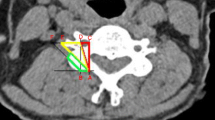Abstract
Placement of C1 lateral mass screws may be facilitated by intentional C2 root sacrifice. Functional outcomes and morbidity following intentional sacrifice of the C2 root have not been reported in the literature. The objective is to find out if intentional C2 nerve root sacrifice affects functional outcomes and operative morbidity in patients undergoing posterior cervical fusion with C1 lateral mass screws. The study is a case report. Twenty-two consecutive elderly patients (10 males, 12 females with an average age of 77 years) with C1–2 instability were treated with posterior cervical fusion using C1 lateral mass screw placement. Five patients had preservation of the bilateral C2 nerve roots (PRES group) and 18 patients had intentional sacrifice of the bilateral C2 nerve root (SAC group). Operative times, blood loss, hospital length of stay, and complications were recorded for each patient. Functional outcomes, pain, and satisfaction scores were compared between the two groups at the time of ultimate follow-up. Average follow-up time was 19.3 months (range 6–66). The SAC group demonstrated significantly decreased operative time (109.4 vs. 187 min) and a trend towards decreased blood loss (344 vs. 1,030 mL). At ultimate follow-up both groups experienced similar mild disability with no significant difference in NDI scores, analog pain, and satisfaction scores. No patient had C2 root dysesthesia, swallowing, or speech difficulty. In this small case series, intentional sacrifice of the bilateral C2 nerve root ganglion resulted in less operative time and decreased blood loss in elderly patents undergoing C1–2 posterior fusion with the Harms technique. Functional outcome, pain and satisfaction scores were not adversely affected when this technique was used in elderly patients.






Similar content being viewed by others
References
Aryan HE, Newman CB, Nottmeier EW, Acosta FL Jr, Wang VY, Ames CP (2008) Stabilization of the atlantoaxial complex via C-1 lateral mass and C-2 pedicle screw fixation in a multicenter clinical experience in 102 patients: modification of the Harms and Goel techniques. J Neurosurg Spine 8:222–229. doi:10.3171/spi.2008.8.3.222
Lozano AM, Vanderlinden G, Bachoo R, Rothbart P (1998) Microsurgical C-2 ganglionectomy for chronic intractable occipital pain. J Neurosurg 89:359–365
Goel A, Desai KI, Muzumdar DP (2002) Atlantoaxial fixation using plate and screw method: a report of 160 treated patients. Neurosurgery 51:1351–1356 (discussion 1356–1357)
Rocha R, Safavi-Abbasi S, Reis C, Theodore N, Bambakidis N, de Oliveira E, Sonntag VK, Crawford NR (2007) Working area, safety zones, and angles of approach for posterior C-1 lateral mass screw placement: a quantitative anatomical and morphometric evaluation. J Neurosurg Spine 6:247–254. doi:10.3171/spi.2007.6.3.247
Harms J, Melcher RP (2001) Posterior C1–C2 fusion with polyaxial screw and rod fixation. Spine (Phila Pa 1976) 26:2467–2471
En MC, Clair DA, Edmondston SJ (2009) Validity of the neck disability index and neck pain and disability scale for measuring disability associated with chronic, non-traumatic neck pain. Man Ther 14:433–438
Vernon H (2008) The neck disability index: state-of-the-art, 1991–2008. J Manip Physiol Ther 31:491–502. doi:10.1016/j.jmpt.2008.08.006
McCarthy MJ, Grevitt MP, Silcocks P, Hobbs G (2007) The reliability of the Vernon and Mior neck disability index, and its validity compared with the short form-36 health survey questionnaire. Eur Spine J 16:2111–2117. doi:10.1007/s00586-007-0503-y
Tan M, Wang H, Wang Y, Zhang G, Yi P, Li Z, Wei H, Yang F (2003) Morphometric evaluation of screw fixation in atlas via posterior arch and lateral mass. Spine (Phila Pa 1976) 28:888–895. doi:10.1097/01.BRS.0000058719.48596.CC
Halm EA, Wang JJ, Boockvar K, Penrod J, Silberzweig SB, Magaziner J, Koval KJ, Siu AL (2004) The effect of perioperative anemia on clinical and functional outcomes in patients with hip fracture. J Orthop Trauma 18:369–374. doi:00005131-200407000-00007
Rosse C, Gaddum-Rose P (1997) The neck. Hollinshead, Philadelphia
Wilbourn AJ (2007) Plexopathies. Neurol Clin 25:139–171. doi:10.1016/j.ncl.2006.11.005
Acar F, Miller J, Golshani KJ, Israel ZH, McCartney S, Burchiel KJ (2008) Pain relief after cervical ganglionectomy (C2 and C3) for the treatment of medically intractable occipital neuralgia. Stereotact Funct Neurosurg 86:106–112. doi:10.1159/000113872
Wang MY, Levi ADO (2002) Ganglionectomy of C-2 for the treatment of medically refractory occipital neuralgia. Neurosurg Focus 12:3
Rhee WT, You SH, Kim SK, Lee SY (2008) Troublesome occipital neuralgia developed by C1–2 Harms Construct. J Korean Neurosurg Soc 43:3
Pearson J, Sculco T, Spence R, Keating E (2007) Blood products: maximal use, conservation, pre deposit blood, when to transfuse and erythropoietin. In: Instructional course lecture. AAOS, New Orleans
Reeves BC, Murphy GJ (2008) Increased mortality, morbidity, and cost associated with red blood cell transfusion after cardiac surgery. Curr Opin Anaesthesiol 21:669–673. doi:10.1097/ACO.0b013e32830dd087
Acknowledgments
The authors wish to thank Kimberly Napoli for editorial assistance in preparing this manuscript.
Author information
Authors and Affiliations
Corresponding author
Rights and permissions
About this article
Cite this article
Squires, J., Molinari, R.W. C1 lateral mass screw placement with intentional sacrifice of the C2 ganglion: functional outcomes and morbidity in elderly patients. Eur Spine J 19, 1318–1324 (2010). https://doi.org/10.1007/s00586-010-1452-4
Received:
Revised:
Accepted:
Published:
Issue Date:
DOI: https://doi.org/10.1007/s00586-010-1452-4




